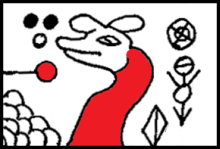| Ersu Shaba | |
|---|---|
 | |
| Script type | Pictographic
|
Time period | ca. 1000–1500 CE to present |
| Languages | Ersu |
The Ersu Shaba script, also called Ersu Shaba Picture Writing and known in Ersu as [ndzārāmá], is the writing system used in texts of the indigenous religion of the Ersu people, which is rendered in Chinese as Shābā (沙巴). These scriptures are recited in divination and when treating the sick. The script is used for non-scriptural texts as well, such as astrological almanacs, but predominantly ones which concern religion. Only Shaba priests are literate in the script.
The script is predominantly pictographic. It is limited in scope and is not sufficient to write the Ersu language fully. Some 200 glyphs have been identified, most of them depicting (and resembling) concrete objects. These are combined into composite diagrams. The system is (proto-)writing, as the relationship between form and meaning is fixed: Although glyphs may be written simply or elaborately, they may not be chosen at the author's whim, and pronunciation and interpretation is consistent across the several counties of the Ersu-speaking area. However, it typically takes many words to explain a few glyphs; the connection to language is definite in the object depicted, but the position and context of the glyphs does not have a fixed linguistic correlation.
Writing is done with a bamboo brush or animal hair dipped in white, black, red, blue, green, and yellow-colored ink. The color chosen may affect the meaning. For example, the glyph 'stars and moon' written in black means 'dim', but written in white it means 'shining' (Sun 2009:165).